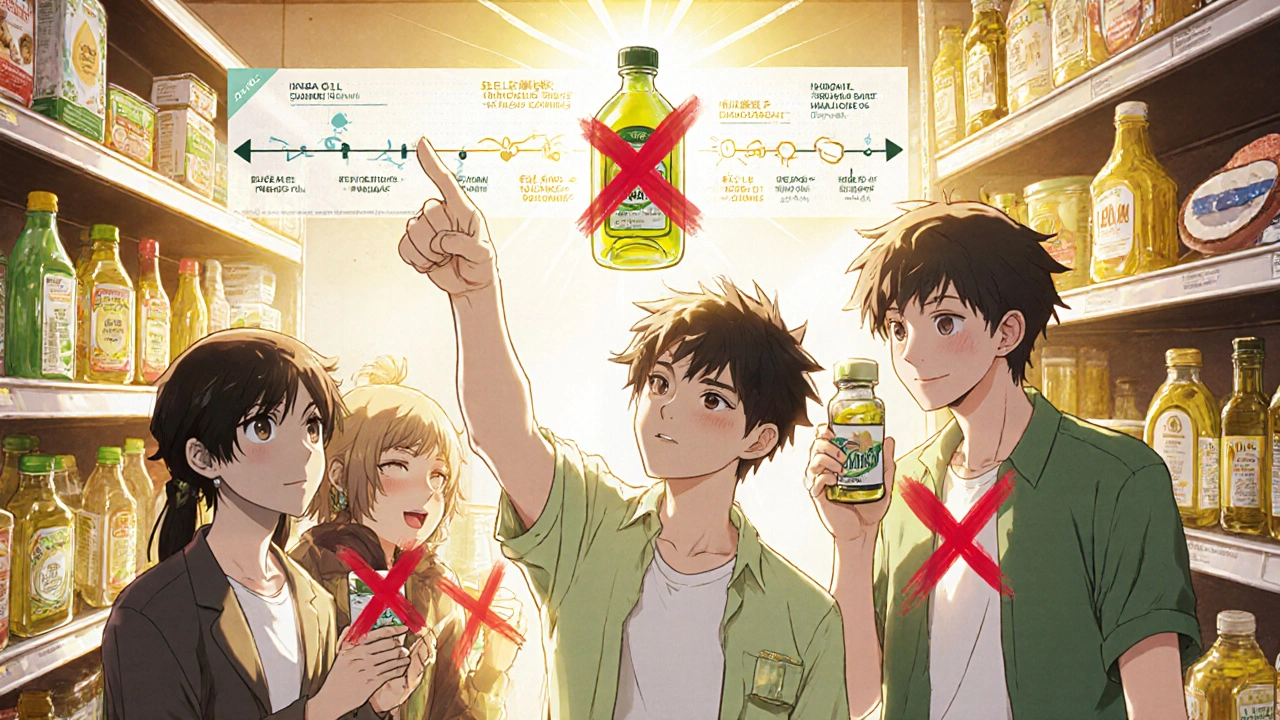Why Your Cooking Oil Matters More Than You Think
Heart disease kills nearly 18 million people every year. That’s more than cancer, diabetes, and accidents combined. And while genetics and activity play a role, what you cook with every day has a bigger impact than most people realize. Swapping out the wrong oils for the right ones can lower your bad cholesterol by up to 15%-no pills needed. It’s not about cutting fat. It’s about choosing the right kind.
What Makes an Oil Heart-Healthy?
Not all fats are created equal. The difference between a heart-protective oil and a heart-risking one comes down to three things: the type of fat, how it’s processed, and how it behaves when heated.
Heart-healthy oils are packed with monounsaturated fats and omega-3s. These fats help lower LDL (the "bad" cholesterol) and reduce inflammation in your arteries. They also tend to be low in saturated fat-ideally under 15% of total fat content. And they’re minimally processed. Cold-pressed or expeller-pressed oils keep more of their natural antioxidants, like polyphenols, which act like little bodyguards for your blood vessels.
On the flip side, avoid anything with partially hydrogenated oils. That’s the technical term for artificial trans fats. Even if the label says "0g trans fat," if it lists hydrogenated oils in the ingredients, skip it. The FDA banned them in most processed foods, but loopholes still let some sneak in-especially in baked goods and fried snacks.
The Best Oils for Your Kitchen
Here’s what actually works, based on real science and real cooking needs:
- Extra virgin olive oil: 73% monounsaturated fat, 14% saturated. Packed with polyphenols that fight inflammation. Best for salad dressings, drizzling, and low-heat sautéing. Smoke point: 375-410°F.
- Avocado oil: 67% monounsaturated fat, 12% saturated. High smoke point (520°F) makes it perfect for searing, roasting, and grilling. Neutral taste. Costs more, but lasts longer because you don’t burn it.
- Algae oil: 86% monounsaturated fat, 11% saturated. Highest smoke point of any cooking oil (535°F), neutral flavor, and no strong taste to overpower food. Still hard to find in regular stores, but growing fast. Great for high-heat cooking without the cost or flavor of avocado oil.
- Canola oil: 62% monounsaturated fat, 7% saturated. One of the few common oils with a decent amount of omega-3 (ALA). Affordable and versatile. Smoke point around 400°F. Good for baking and stir-fries.
Stick with these four, and you’re ahead of 80% of home cooks.
Oils to Avoid (Even If They Sound Healthy)
Some oils are marketed as "natural" or "superfoods," but they’re not heart-friendly.
- Coconut oil: 82% saturated fat. That’s more than butter. The American Heart Association says it raises LDL cholesterol. Don’t be fooled by claims about "medium-chain triglycerides." The science doesn’t back it for heart health.
- Corn, sunflower, and safflower oils: These are high in omega-6 fats. A little is fine. Too much? It triggers inflammation. Most people already get way too much omega-6 from processed snacks and fried foods. Adding more oil won’t help.
- Palm oil: Often hidden in spreads and baked goods. High in saturated fat and linked to deforestation. Skip it unless it’s certified sustainable-and even then, there are better options.

How to Read a Food Label Like a Nutritionist
You can’t trust marketing buzzwords like "natural," "light," or "heart-smart." Here’s what to actually look for:
- Check saturated fat per serving. Aim for less than 2 grams per serving. If it’s over 3 grams, ask yourself: "Do I really need this?"
- Look for "trans fat" on the nutrition panel. If it says "0g," check the ingredients. If you see "partially hydrogenated," walk away.
- Look at the ingredient list. The first ingredient should be the oil. If it’s "vegetable oil," that’s vague. It could be soy, corn, or palm. Better oils are named: "extra virgin olive oil," "avocado oil."
- Watch for "blended oils". These are often cheap oils mixed with a splash of olive oil to look healthy. They’re usually high in omega-6 and low in antioxidants.
- Look for certifications. In Australia, the Heart Foundation Tick means it meets strict criteria for saturated fat and sodium. Similar labels exist in Europe and Canada.
Example: A jar labeled "olive oil blend" might say "0g trans fat" and "low saturated fat." But if the first ingredient is canola oil, and olive oil is third? You’re not getting the benefits you think.
Smoke Point Matters More Than You Think
Heating oil past its smoke point doesn’t just ruin flavor. It creates harmful compounds that damage cells and promote inflammation. That’s the opposite of heart-healthy.
Match your oil to your cooking method:
- Low heat (under 375°F): Extra virgin olive oil for drizzling, dressings, gentle sautéing.
- Medium heat (375-400°F): Regular olive oil, canola oil for stir-fries, baking.
- High heat (400°F and up): Avocado oil, algae oil for roasting, searing, deep frying.
Never reuse oil more than twice. Each time you heat it, the chemical structure breaks down. Used oil is more likely to smoke at lower temperatures and lose its health benefits.
Storage Tips to Keep Oils Fresh
Oil doesn’t last forever. Sunlight and heat turn it rancid. Rancid oil tastes stale and can increase oxidative stress in your body.
- Store oils in dark glass bottles, not clear plastic.
- Keep them in a cool, dark cupboard-not next to the stove.
- Refrigerate flaxseed, walnut, and algae oils. They’re high in polyunsaturated fats and go bad fast.
- Use opened bottles within 3-6 months. If it smells like crayons or old nuts, toss it.

Real-Life Swaps That Work
You don’t need to overhaul your whole kitchen. Start with these easy changes:
- Swap butter for olive oil when sautéing veggies.
- Use avocado oil instead of vegetable oil for roasting potatoes or chicken.
- Make your own salad dressing with olive oil, lemon, and herbs instead of bottled ranch.
- Choose whole-grain crackers with avocado oil instead of chips fried in corn oil.
- When baking, replace half the butter with unsweetened applesauce or mashed banana-then use canola or olive oil for the rest.
Small changes add up. One study found people who swapped just one tablespoon of butter for olive oil daily lowered their heart disease risk by 7% over five years.
What About Coconut Oil? The Controversy Explained
You’ve heard it’s "good for you." But here’s the truth: The only major health organization that recommends coconut oil for heart health is a small group of influencers. The American Heart Association, the World Health Organization, and the Heart Foundation of Australia all say no. It’s 82% saturated fat. That’s worse than lard. It raises LDL cholesterol. Period.
There’s no solid evidence that the "medium-chain" fats in coconut oil protect your heart. Some test-tube studies show benefits, but those don’t translate to real people eating real diets. If you like the taste, use it sparingly. But don’t call it heart-healthy.
What’s New in 2025?
Algae oil is no longer a niche product. It’s now in 25,000+ U.S. stores and slowly making its way to Australian supermarkets. It’s sustainable, neutral in flavor, and has the highest smoke point of any cooking oil. It’s also more expensive-but you use less because it doesn’t burn.
And new research is showing that the polyphenols in extra virgin olive oil-like oleocanthal-act like a natural anti-inflammatory, similar to ibuprofen. That’s why Mediterranean diets, rich in olive oil, are linked to lower rates of heart disease, stroke, and even dementia.
The bottom line? The science hasn’t changed. But the options have gotten better. You don’t need to cook like a chef. Just choose better oils, read labels, and avoid the hype.
What’s the best oil for frying chicken?
Avocado oil or algae oil are your best bets. Both have smoke points above 500°F, so they won’t break down or create harmful compounds when frying. Olive oil smokes too easily at high heat, and canola oil, while okay, doesn’t handle prolonged high heat as well. For best results, keep the oil between 350-375°F and don’t reuse it more than twice.
Is olive oil still good if it’s not extra virgin?
Yes, but it’s not the same. Extra virgin olive oil has the highest levels of antioxidants and polyphenols because it’s cold-pressed and unrefined. Regular olive oil is refined, which removes some flavor and health compounds. It’s still better than most other oils for cooking at medium heat, but it won’t give you the same anti-inflammatory benefits. If you’re using it for sautéing or baking, regular olive oil is fine. For dressings or drizzling, go extra virgin.
Can I use butter sometimes?
Occasionally, yes. Butter isn’t poison. But it’s high in saturated fat-about 7 grams per tablespoon. The American Heart Association recommends limiting saturated fat to less than 10% of your daily calories. For a 2,000-calorie diet, that’s about 22 grams total per day. If you’re using butter on toast or in baking, make sure the rest of your day’s fats come from olive oil, avocado oil, or nuts. Don’t make butter your main cooking fat.
What if I can’t find algae oil?
Don’t stress. Avocado oil is your next best option. It’s widely available, has a high smoke point, and is backed by solid science. Canola oil is a budget-friendly alternative for baking and stir-fries. The goal isn’t to buy the most expensive oil-it’s to avoid the worst ones. Skip the hydrogenated oils, limit coconut and palm oil, and stick with olive, avocado, or canola as your go-tos.
Are "light" or "low-fat" oils better?
No. "Light" on an oil label doesn’t mean less fat-it means less flavor or color. All oils are 100% fat by nature. A "light" olive oil is just more refined, with fewer antioxidants. It’s not healthier. Stick to oils labeled "extra virgin," "cold-pressed," or "unrefined" if you want the real benefits.
Next Steps: Start Today
Here’s your 5-minute action plan:
- Check your pantry. Toss any oil with "partially hydrogenated" in the ingredients.
- Replace your main cooking oil with avocado or olive oil.
- Buy one bottle of extra virgin olive oil for dressings and drizzling.
- Read the nutrition label on your next snack. If saturated fat is over 2g per serving, pick something else.
- Next time you cook, ask: "Is this oil helping my heart-or hurting it?"
You don’t need to be perfect. Just make better choices, one meal at a time. Your arteries will thank you.





